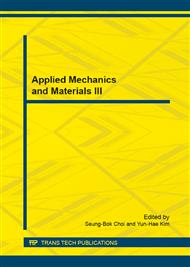[1]
A. Jorn, P. Reinhard, K. Sebastian et al: Assessment of hemolysis related quantities in a microaxial blood pump by computational fluid dynamics. Artificial Organs Vol. 25(2001), pp.341-347.
DOI: 10.1046/j.1525-1594.2001.025005341.x
Google Scholar
[2]
G.A. Giridharan, A. Michael. M.A. Sobieski et al: Blood trauma testing for mechanical circulatory support devices. Biomed Instrum Technol Vol. 45(2011), pp.334-339.
DOI: 10.2345/0899-8205-45.4.334
Google Scholar
[3]
A. Aziz and B.C. WERNER: The cumulative and sublethal effects of turbulence on erythrocytes in a stirred-tank model. Ann Biomed Eng Vol. 35(2007), pp.2108-2120.
DOI: 10.1007/s10439-007-9387-6
Google Scholar
[4]
N. Watanabe and Y. Arakawa: Deformability of human red blood cells exposed to a uniform shear stress as measured by a cyclically reversing shear flow generator. Physiol. Meas Vol. 28(2007), pp.531-545.
DOI: 10.1088/0967-3334/28/5/007
Google Scholar
[5]
O.K. Baskurt, M. Uyuklu and H.J. Meiselman: Protection of erythrocytes from sub-hemolytic mechanical damage by nitric oxide mediated inhibition of potassium leakage. Biorheology Vol. 41(2004), pp.79-89.
Google Scholar
[6]
M. KODÍČEK, J. SUTTNAR, L. MIRČEVOVÁ et al: Red blood cells under mechanical stress. Gen. Physiol. Biophys Vol. 9(1990), pp.291-299.
Google Scholar
[7]
B.N. NANJAPPA, H.K. CHANG and C.A. GLOMSKI: Trauma of the erythrocyte membrane associated with low shear stress. Biophysical journal Vol. 13(1973), pp.1212-1222.
DOI: 10.1016/s0006-3495(73)86056-4
Google Scholar
[8]
M.K. AMENEVA, P.F. MARAD and M. JAMES: In vitro evaluation of hemolysis and sublethal blood trauma in a novel subcutaneous vascular access system for hemodialysis. ASAIO Journal Vol. 48(2002), pp.34-38.
DOI: 10.1097/00002480-200201000-00008
Google Scholar
[9]
M. Mehrdad, K. Jeongho and F.A. James: Modeling and numerical simulation of blood flow using the theory of interacting continua. International Journal of Non-Linear Mechanics Vol. 47(2012), pp.506-520.
DOI: 10.1016/j.ijnonlinmec.2011.09.025
Google Scholar
[10]
Y. Alemu and D. Bluestein: Flow-induced platelet activation and damage accumulation in a mechanical heart valve Numerical studies. Artificial Organs Vol. 31(2007), pp.677-688.
DOI: 10.1111/j.1525-1594.2007.00446.x
Google Scholar
[11]
Y.J. Xuan, Y. Chang, K.Y. Gu et al: Hemodynamic simulation study of a novel intra-aorta left ventricular assist device. ASAIO Journal Vol. 58(2012), pp.462-469.
DOI: 10.1097/mat.0b013e318268eaf7
Google Scholar
[12]
B. Gao, K.Y. Gu, Y. Zeng et al: A blood assist index control by intraaorta pump: a control strategy for ventricular recovery. ASAIO Journal Vol. 57(2011), pp.358-362.
DOI: 10.1097/mat.0b013e3182257fac
Google Scholar
[13]
X.W. Song: Computational fluid dynamics prediction of blood damage in a centrifugal pump. Artificial Organs Vol. 27(2003), pp.938-941.
DOI: 10.1046/j.1525-1594.2003.00026.x
Google Scholar
[14]
R.A. Malinauskas: Plasma hemoglobin measurement techniques for the in vitro evaluation of blood damage caused by medical devices. Artificial Orgaris Vol. 21(1997), pp.1255-1267.
DOI: 10.1111/j.1525-1594.1997.tb00486.x
Google Scholar
[15]
K.Y. Gu, Y. Chang, B. Gao et al: Lumped Parameter Model for Heart Failure with Novel Regulating Mechanisms of Peripheral Resistance and Vascular Compliance. ASAIO Journal, Vol. 58(2012), pp.223-231.
DOI: 10.1097/mat.0b013e31824ab695
Google Scholar
[16]
A. Mitoh, T. Yano, K. Sekine et al: Computational Fluid Dynamics Analysis of an Intra-Cardiac Axial Flow Pump. Artificial Organs Vol. 27(2003), p.34–40.
DOI: 10.1046/j.1525-1594.2003.07190.x
Google Scholar


